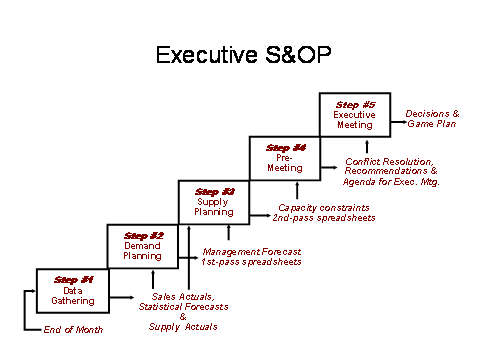|
Wallace Says:
|
 In
response to a surprise,
leaders
quickly execute a Demand
Planning step, a Supply
Planning step, and hold
an abbreviated Pre-Meeting
and Exec Meeting if necessary. In
response to a surprise,
leaders
quickly execute a Demand
Planning step, a Supply
Planning step, and hold
an abbreviated Pre-Meeting
and Exec Meeting if necessary.

What
do you say? Send
us your comments here
|
Risk
is an important topic in business
today, and supply chain management
is right in the middle of discussions
about risk. Potential disruptions
– of moderate to major
consequence – are more
likely today than 20 or even
ten years ago, for reasons that
include:
- Supply
chains lengthening and becoming
less robust
- Natural
disasters occurring at an
increasing frequency
- Terrorism
rising
- And
who knows what’s coming
next
These
factors can lead to significant
disruptions of the demand/supply
balance, and they often come
with little or no warning. They’re
“surprises.” And,
actually, surprises can be not
only bad surprises, but also
good ones – provided they’re
managed effectively.
Can
companies get help with this
from Executive S&OP (the
top management component of
Sales & Operations Planning)?
Well, it can’t make the
surprises go away, but it can
perhaps help you anticipate
them a bit and also to recover
when they occur. For the time
being, let’s focus on
recovery and see how an effective
Executive S&OP process helps
to deal with surprises of both
the good and bad variety. First,
the good:
Demand
Spikes
One
of your biggest customers –
one of the “800 pound
gorilla” variety –
sends in a very large order,
out of the blue, calling for
three times more widgets than
they’ve been taking in
recent months. This may cause
some problems, certainly, but
on balance, it’s good
news: they want to buy more
of your product. How does a
company deal with that? In other
words, how does it recover?
Let’s
say that your monthly Executive
S&OP cycle ended just a
week before this very large
order arrived. Well, you certainly
can’t afford to wait several
weeks for the next planning
cycle to address this problem.
What do companies do in this
situation?
Answer:
they immediately conduct a “mini
Executive S&OP cycle.”
This is an accelerated version
of the standard 5-step Executive
S&OP process shown in the
diagram, dealing only with those
parts of the business affected
by the demand spike: the related
materials, capacity, other resources,
and perhaps other customers.

The
“Mini” Executive
S&OP Cycle
They conduct, quickly, a Demand
Planning step, a Supply Planning
step, and hold an abbreviated
Pre-Meeting and Exec Meeting
if necessary. Decisions are
made and the issue is resolved
at the lowest level possible.
If the folks in the Demand Planning
step can solve the problem by
shifting customer commitments
around somewhat, fine. Case
closed. Or perhaps the Supply
Planning team can pull a rabbit
out of the hat: excellent. Problem
met and resolved.
But if not, the issue gets elevated
to a mini Pre-Meeting for resolution
and then to a mini Exec Meeting
if the situation warrants. These
meetings are typically much
shorter than those in the monthly
cycle; they focus on the issue
at hand and related factors,
with probably more than a few
of the participants attending
via telephone.
Throughout the abbreviated process,
they try to keep the steps,
the report formats, and the
decision-making process the
same — because the people
are familiar with those processes
and know they’re solid.
And of course the information
is in dollars as well
as units; the Finance folks
are involved in this process,
remember? The dollar view, obviously,
is necessary to make decisions
that are in the best financial
interests of the company.
Thus there is a coordinated
and rapid response to the demand
spike. At worst, and hardly
ever likely, the company may
conclude that it can do nothing.
Or perhaps it can supply some,
but not all of the order when
the customer wants it, with
the balance later. Or just maybe
it can meet all of this customer’s
demand and still keep its commitments
to the other customers, who
may be only “600 pound
gorillas.”
A
few years ago, I co-authored
a book – ERP: Making
It Happen – with
Mike Kremzar, formerly Vice
President of Product Supply
at Procter & Gamble. Mike
was the “force”
behind the implementation of
Executive S&OP at the company.
Mike identified one of S&OP’s
big benefits was the creation
of a common, agreed-upon game
plan throughout each business.
This
makes mid-period corrections,
of the type we’re talking
about here, much easier than
before. Mike indicated that
they no longer had to spend
the first X days debating whose
numbers were right; there was
only one set of numbers.
They could get to work quickly,
and develop the recovery plans.
In
a future column, I’ll
address how to deal with “bad
surprises” – supply
crashes.
Agree or disgree with our expert's
perspective? What would you
add? Let us know your thoughts
for publication in the SCDigest
newsletter Feedback section,
and on the web site. Upon request,
comments will be posted with
the respondents name or company
withheld. |